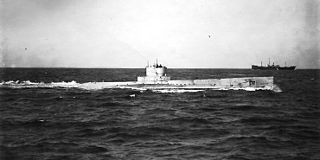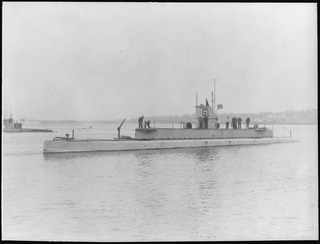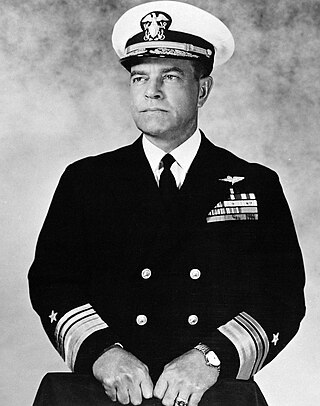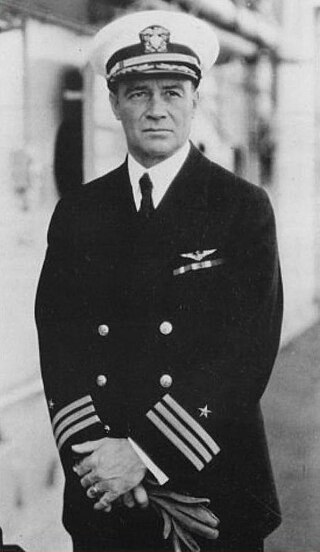
Chester William Nimitz was a fleet admiral in the United States Navy. He played a major role in the naval history of World War II as Commander in Chief, US Pacific Fleet, and Commander in Chief, Pacific Ocean Areas, commanding Allied air, land, and sea forces during World War II.

USS R-14 (SS-91) was an R-class coastal and harbor defense submarine of the United States Navy.

USS Dwight D. Eisenhower (CVN-69) is a nuclear-powered aircraft carrier currently in service with the United States Navy. Commissioned in 1977, the ship is the second of the ten Nimitz-class aircraft carriers currently in service, and is the first ship named after the 34th President of the United States and General of the Army Dwight D. Eisenhower. The vessel was initially named simply as USS Eisenhower, much like the lead ship of the class, Nimitz, but the name was changed to its present form on 25 May 1970. The carrier, like all others of her class, was constructed at Newport News Shipbuilding Company in Virginia, with the same design as the lead ship, although the ship has been overhauled twice to bring her up to the standards of those constructed more recently.

USS Argonaut (SS-475) was a Tench-class submarine operated by the United States Navy (USN). Constructed at Portsmouth Navy Yard during the second half of 1944, Argonaut was commissioned into the USN in 1945 and operated during the final year of World War II, although her only contact with the Japanese was when she sank a junk in August. During the 1950s, the submarine was modified for greater underwater endurance, and to guide the Regulus I missile. From 1963 to 1965, Argonaut operated in the Mediterranean Sea.

USS G-1 (SS-19½) was the lead ship of her class of submarine of the United States Navy. While the four G-boats were nominally all of a class, they differed enough in significant details that they are sometimes considered to be four unique boats, each in a class by herself.

USS Harder (SS-568), a Tang-class submarine, was the second ship of the United States Navy to be named for the harder, a fish of the mullet family found off South Africa.

USS Damato (DD-871) was a Gearing-class destroyer of the United States Navy. She was named for Corporal Anthony P. Damato USMC (1922–1944), who was killed in action during the Battle of Eniwetok in the Marshall Islands and posthumously awarded the Medal of Honor.

USS Hawkins (DD-873) was a Gearing-class destroyer in the United States Navy during World War II. Following the war, the ship saw service in the Korean War and in the 1970s, was transferred to the Republic of China Navy as Tze Yang. She remained in service until the 1990s. The ship was then scrapped with the exception of her superstructure, which became part of a display and training ground at the Zuoying Naval Academy.

USS Plunger (SS-2) was one of the earliest submarines of the United States Navy. She was the lead boat of her class and was later renamed A-1 when she was designated an A-type submarine. She is not to be confused with the experimental submarine Plunger which was evaluated by the U.S. Navy from 1898 to 1900, but not accepted or commissioned.

USS Shark (SSN-591), a Skipjack-class submarine, was the seventh ship of the United States Navy to be named for the shark.

USS E-2 (SS-25) was an E-class submarine of the United States Navy. Originally named Sturgeon, the boat was launched on 15 June 1911 by the Fore River Shipyard, Quincy, Massachusetts; sponsored by Ms. Margaret Nelson Little; renamed E-2 on 17 November 1911; and commissioned on 14 February 1912d.

The second USS Menhaden (SS-377) was United States Navy Balao-class submarine. Launched in 1944, she operated out of Pearl Harbor until 1946, then continued in use out of various ports in the Pacific until the 1970s. She was then decommissioned and re-fitted as a remotely controlled, unmanned acoustic test vehicle known as the "Yellow Submarine", until she was scrapped in 1988.

The first USS Patterson (DD-36) was a modified Paulding-class destroyer in the United States Navy during World War I and later in the United States Coast Guard, designated as CG-16. She was named for Daniel Patterson.

USS G-4 (SS-26) was a G-class submarine of the United States Navy. While the four G-boats were nominally all of a class, they differed enough in significant details that they are sometimes considered to be four unique boats, each in a class by herself.

USS G-2 (SS-27) was a G-class submarine of the United States Navy. While the four G-boats were nominally all of a class, they differed enough in significant details that they are sometimes considered to be four unique boats, each in a class by herself. G-2 was named Tuna when her keel was laid down on 20 October 1909 by the Lake Torpedo Boat Company in Bridgeport, Connecticut, making her the first ship of the United States Navy to be named for the tuna, a large, vigorous, spiny-finned fish highly esteemed for sport and food. She was renamed G-2 on 17 November 1911, launched on 10 January 1912 sponsored by Ms. Marjorie F. Miller, towed to the New York Navy Yard after the termination of the Lake contract on 7 November 1913 where she was completed, and commissioned on 1 December 1913.

USS D-1 (SS-17) was the lead ship of the D-class submarines of the United States Navy. Her keel was laid down by Fore River Shipbuilding Company in Quincy, Massachusetts, under a subcontract from Electric Boat Company of Groton, Connecticut, as Narwhal, making her the first ship of the United States Navy to be named for the narwhal, a gray and white arctic whale which averages 20 feet in length, the male of which has a long, twisted ivory tusk of commercial value. Narwhal was launched on 8 April 1909 sponsored by Mrs. Gregory C. Davison, and commissioned on 23 November 1909.

USS C-5 (SS-16) was one of five C-class submarines built for the United States Navy in the first decade of the 20th century.

USS Holder (DD/DDE-819) was a Gearing-class destroyer of the United States Navy, the second Navy ship named for Lieutenant (jg) Randolph Mitchell Holder, a Navy pilot who was killed during the Battle of Midway.

Patrick Nieson Lynch Bellinger CBE was a highly decorated officer in the United States Navy with the rank of Vice Admiral. A Naval aviator and a naval aviation pioneer, he participated in the Trans-Atlantic flight from Newfoundland to Azores in May 1919 and was decorated with Navy Cross, the United States military's second-highest decoration awarded for valor.

Kenneth Whiting was a United States Navy officer who was a pioneer in submarines and is best known for his lengthy career as a pioneering naval aviator. During World War I, he commanded the first American military force to arrive in Europe for combat. After the war, he was instrumental in development of the aircraft carrier in the United States, where he sometimes is known as the U.S. Navy's "father of the aircraft carrier." He was involved in some way in the design or construction of five of the first six U.S. Navy aircraft carriers, and served as acting commanding officer of the first carrier to enter U.S. Navy service and as executive officer of the first two American carriers. In the earliest days of the U.S. Navy's development of an aircraft carrier force, he led many shipboard innovations still in use aboard carriers today.




















